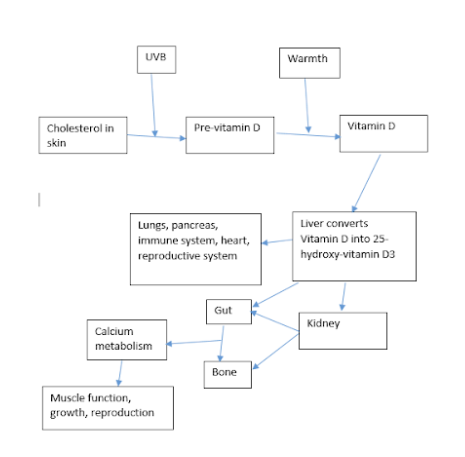There are three forms of UV light (none of which is visible to the human eye), defined by their differing wavelengths: UVA, UVB and UVC. UVA is important in stimulation of normal behaviour, including appetite. UVB reacts with products in the skin and feathers to assist in the production of vitamin D, a vitamin important not only for healthy bones, but involved in many bodily processes. UVC is a damaging form of UV light, and can predispose to cancer. Due to our busy lives, there is a tendency to keep our pets indoors, without exposure to unfiltered natural sunlight, which can result in health issues. Flyscreens, glass windows and other light filters will reduce the amount of UV or prevent any UV from getting to your pet.
UVB light is naturally found in sunlight and reacts with compounds in the skin to produce vitamin D, which is heavily involved in calcium metabolism. Calcium is obviously very important for strong bones so unfortunately when our animals don’t get enough of this they can end up with metabolic bone disease – a condition where they get soft bones that are more prone to breaking.
There are a number of factors that contribute to this condition and lack of UV light is one of them. Metabolic bone disease is most commonly encountered in lizards, turtles and frogs. Snakes ingest entire prey items that have vitamin D present within them, so even without the provision of UV light snakes don’t get nutritional metabolic bone disease. However we still recommend the provision of an appropriate day-night cycle for snakes, and UV light has many important benefits apart from calcium metabolism and in an ideal world would still be provided.
Clinical signs of Metabolic Bone Disease
- Stunted growth or weight loss
- Deformities, particularly of the spine, head and shell
- Soft bones and fractures
- Poor appetite
- Constipation and/or cloacal prolapse
- Abnormal movement or weakness
- Twitching, tremoring, seizures, paralysis
- Death
Diagnosis of metabolic bone disease usually involves a physical exam, an examination of the animal’s diet and UV light exposure, blood tests and x-rays. The precise combination of tests varies from case to case. The good news is that this disease can be prevented by providing your reptile with adequate husbandry.
The following three items are required to maintain healthy bones and normal blood calcium levels:
Calcium
-
- Gut load insects
- Dust insects with calcium powder immediately prior to feeding
- Dust or spray vegetables with calcium
- Use a plain calcium supplementation, not a vitamin and mineral supplement
- Reptiles can also develop low blood calcium levels without deformities and this can result in tremoring, seizures and other clinical signs.
Vitamin D
-
- Provide adequate UV exposure (the body needs this to activate vitamin D)
- Supplement the food once a week with a commercially available vitamin and mineral supplement. Do not over supplement with these products.
UV light
-
- A UV light is needed unless you take your reptile outside into full natural sunlight for 20 minutes per day.
- UV light doesn’t penetrate sufficiently through glass or Perspex so ensure these are not present between your reptile and the UV bulb
- The bulb needs to be changed every 6 – 9 months as it will stop producing UV light as it ages. Visible light, without UV light, can be produced for years
Treatment involves correcting any poor husbandry and often veterinary intervention is also necessary. If you are worried your reptile could have metabolic bone disease please feel free to call the clinic today.
What UV lamp do I choose?
The good news for reptile owners is that there are many UV lamps available and marketed for pet reptiles. These come in various shapes, sizes and strengths. What we need to remember when deciding on a lamp is that the aim of captivity is to mimic the wild type environment as closely as possible. This means that the sunlight requirements for a green tree frog that lives in shaded areas are quite different to that of a bearded dragon that lives in the desert. Generally UV lamps come in a few strengths – 2.0 – 10.0. If you are unsure which type your pet requires feel free to call the clinic, in general 2.0 strength UV lamps are used for rainforest dwelling creatures (e.g. frogs) and 10.0 are used for desert species (e.g. some dragons, monitors).
Some heating lamps give out UV light as part of their light spectrum. If your lamp does not, or you are uncertain, then UV light should be supplied separately to your reptile’s heating. In summer, the UV light should be on for 12-14 hours per day, while in winter this can reduce to 9-12 hours. The UV component of any light source will degrade faster than the visible light source, so it is recommended to change the globe every 6-9 months.
It is also important to note that your reptile should always have access to shade from their UV light. Just as reptiles require a gradient for heating, it is important that they have a ‘light gradient’ also, and have access to both full and dappled light, as well as hides that allow them protection from UV. If we don’t allow our reptiles shelter from UV light they may be more prone to developing various skin cancers (squamous cell carcinoma and melanoma).
If you’re unsure what type of UV light your reptile needs please feel free to call the clinic today.




